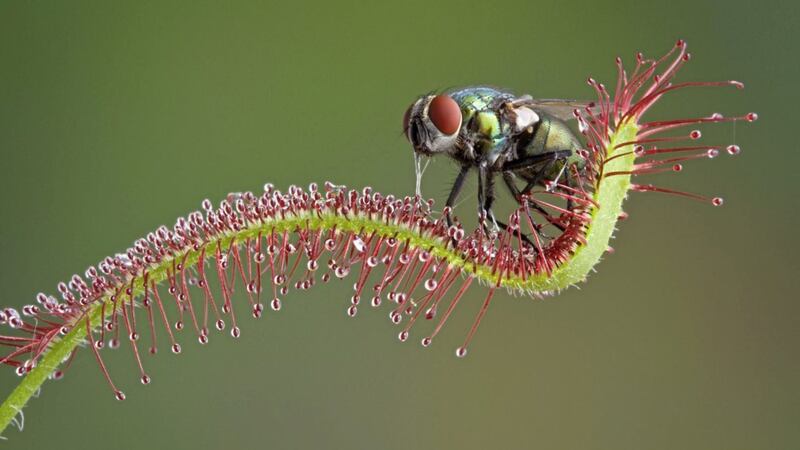A FEMALE correspondent and friend of Charles Darwin, Lady Ellen Lubbock, sent him part of a poem she wrote after reading his work Insectivorous Plants (1875). It included the verse:
I never trusted Drosera
Since I went there with a friend,
And saw its horrid tentacles
Beginning all to bend.
I came across Drosera rotundifolia recently in a local bog. Round-leaved sundew is one of the three species of sundew present in Irish bogs. Insectivorous plants, they are a specialised group adapted to growing and surviving in nutrient-poor habitats. They attract, trap and digest their prey, absorbing mineral nutrients which are in short supply in their bog-land home.
Insects are the predominant source of nutrition for the plant, with its weak roots providing only moisture and anchorage. Sundews are found on wet heaths and bogs, often on bare peat or among sphagnum mosses at low altitude. They are characterised by their basal rosette of reddish/orange leaves which are covered in hairs, each one topped by a sweet sticky excretion.
The hairy leaves of the round-leaved sundew are up to 1cm across and were described as "all whiskery like a bee’s leg’’ by a Connemara man to Irish naturalist Robert Lloyd Praeger (The Way That I Went, 1937). These red ‘hairs’ are like tentacles which secrete sticky, digestive juices and are extremely responsive to animal touch, closing around prey until the leaf is like a closed fist. The two less common sundew species, oblong-leaved and great sundew, are found mainly in the west of Ireland.
Darwin was fascinated by carnivorous plants, especially the sundew family. He believed, after much experimentation, that the movement-sensing organ in sundews is far more sensitive than any nerve in the human body. Even the smallest gnat touching one of the sticky hairs of the plant was, he discovered, enough to start the process of bending the leaf in on itself to get as many sticky hairs to touch the prey and start the digestion.
His interest with these plants was very much in keeping with the cultural interest in gothic horror through literature and art in Victorian England.
The glistening droplet at the end of each hair was mistaken, by medieval observers, for dew and they assumed the plant, unlike all others, could retain its dew even in full sunlight – hence sundew got its name.
Known as the Blessed Virgin’s chalice in Limerick, sundew had a reputation as a cure for asthma where the leaves were chopped up finely and the juice squeezed out before being bottled and used as needed. A mixture of sundew leaves boiled in milk was also given to children as a cure for the whooping cough and a herbalist near Dublin advertised that he would buy "a pound weight of Drosera for £1 to make a cough remedy".
Its Irish names include drúchtín móna, dew of the bog and cailís Mhuire, Mary’s chalice. Cameron, who noted the plant was used by Celtic tribes for dyeing hair, gave it the Irish name, eil druich, eil meaning ‘to rob’ and druich, meaning dew (The Gaelic Names of Plants, 1883). Irish lexicographer and historian Patrick Dinneen wrote the Irish phrase ‘galar nag cat’ meaning ‘a disease among lambs caused by eating sundew, where the tips of their ears fall off’.
If you're out across some local bog and heather during the summer months, keep an eye out and underfoot for this remarkable plant of reddish hue with its "webwork of carnivorous rubies". (The Sun Underfoot Among the Sundews, from The Collected Poems of Amy Clampitt, 1997).



